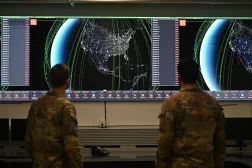Space Force, IC prep to launch more sats that could enable future GMTI missions

The Space Force and Intelligence Community are planning to launch another batch of satellites within the next year that will help the service prepare for an operational ground moving target indication (GMTI) constellation, according to a top service official.
A joint effort between the Space Force, National Reconnaissance Office and National Geospatial Intelligence Agency, the GMTI program aims to develop a constellation of sats equipped with sensors that can track targets moving on the ground or at sea and send the data to warfighters in near real-time. The mission is relatively novel for the service, as it was previously done by the Air Force’s E-8C Joint Surveillance Target Attack Radar System (JSTARS) fleet that retired in 2023.
Speaking during a webinar hosted by the Mitchell Institute on Monday, Lt. Gen. DeAnna Burt, deputy chief of space operations for operations, cyber and nuclear, could not share how many GMTI satellites the Space Force expects to launch due to classification of the program. However, she noted that the service and its partners in the IC have already put a number of “initial satellites” on orbit that carry different enabling capabilities — such as electro-optical sensors, low-end radar capabilities and mesh network communications.
The service has also created a new detachment out of its Delta 7 unit responsible for intelligence, surveillance and reconnaissance that is working with the IC to develop concepts of operations for the new constellation, she added.
“All the exercises and things we’re doing, as the enabling capabilities are coming on board, are going to help us be robust enough that in the next year, when the actual GMTI satellites launch … that we meet it with a full regional squadron in [U.S. Indo-Pacific Command and] a global squadron at Space Forces – Space supporting U.S. Space Command,” Burt said.
On Tuesday, the Space Force issued the following statement to clarify the timeline for satellite launches: “The first launch of satellites dedicated to the GMTI mission is expected in 2028. The satellites Lt Gen Burt referred to as launching in the next year can enable the GMTI mission but were built primarily for other missions.”
Once the GMTI satellites are operational at Indo-Pacom, the Space Force plans to scale the capability to support other combatant commands.
“This is a crawl, walk, run [effort] as the constellation is launched, to build the humans and the training and that data and machine-to-machine [command and control] that has to happen to make it successful,” she said.
The Space Force is hoping that its efforts related to GMTI will inform the service’s work to create a similar constellation able to track targets flying through the air — known as air moving target indication (AMTI).
The Space Force and IC have prototype AMTI satellites on orbit, and officials have previously said the capability could be ready by the early 2030s. But Burt noted there may be opportunities to leverage commercial space capabilities as a way to accelerate fielding the constellation. The service expects to deliver an analysis of alternatives for AMTI sometime this fall, she said.
The future of the mission has been in limbo since the Air Force revealed in its fiscal 2026 budget request that it planned to cancel the program for the E-7 Wedgetail, which was set to replace the service’s fleet of aging E-3 Sentry aircraft that currently conduct AMTI.
Pentagon and service officials at the time argued that emerging space capabilities are able to effectively track airborne targets at a cheaper cost, but others have noted that the technology may not be mature enough for the Air Force’s near-term needs.
Congress, however, appears ready to support both continued work on the E-7 program and development of space-based AMTI capabilities. Lawmakers plan to save Wedgetail for now, as the Senate Appropriations Committee added $647 million to the program in its FY’26 spending bill — bringing the total research-and-development budget to $847 million.
At the same time, Congress added $2 billion for AMTI in the reconciliation bill, which will focus on “how to do the RDT&E of these various capabilities, and how to flush them out and see how they would operate, and then how would you put them together as a constellation,” Burt said.
Updated on Aug. 5, 2025, at 4:50 PM: This story has been updated to include a clarification from the Space Force about the timeline for launching GMTI-related satellites.






